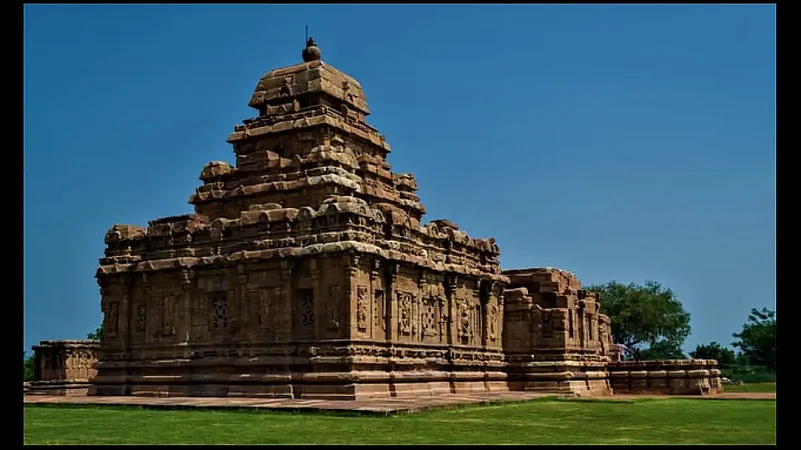Group of Monuments of Pattadakal, Karnataka
Year of inscription: 1987
Usually clubbed with a visit to Badami and Aihole, often visitors can take a cursory glance at the temples of Pattadakal. Not many realise that the temple complex earned its World Heritage Site tag on the basis of its architecture which reflects a harmonious blend of styles from both north and south India. The complex lies on the bank of the Malprabha River. Patronised by the Chalukya rulers, these monuments were built between 7th and 8th centuries. These consist of nine Hindu temples and a Jain sanctuary. The most notable monument is the 8th century Virupaksha Temple said to be have been constructed by Queen Loka Mahadevi to commemorate her husband’s victory in war. The roof of the great hall of this richly carved temple is supported by 16 massive square columns arranged in four rows. Tales from the Puranas have been carved meticulously on these columns.
Advertisement
Champaner-Pavagadh Archaeological Park, Gujarat
Year of inscription: 2004
Off the beaten path, Champaner-Pavagadh Archaeological Park in Gujarat is India’s only complete and unchanged pre-Mughal Islamic city, according to the UNESCO citation. The area contains prehistoric (chalcolithic) sites, a hill fortress of an early Hindu capital, and remains of the 16th-century capital of the state of Gujarat as well as ruins of fortifications, palaces, religious buildings, residential precincts, agricultural structures and water installations, from the 8th to 14th centuries. One of the key criterion that earned the region its World Heritage Site status is the perfect blend of Hindu-Moslem architecture seen in many of the buildings. The Great Mosque (Jami Masjid) is said to have served as a model for later mosque architecture in India. The Kalikamata Temple on top of Pavagadh Hill is an important shrine for the Hindus. The Jain temples mostly belong to the Digmabar sect and are scattered in groups in Pavagadh and Champaner. The twin towns are located about five km apart.
Advertisement
The Jantar Mantar, Jaipur, Rajasthan
Year of inscription: 2010
Rajput ruler, Sawai Jai Singh II, who founded the Pink City of Jaipur, built an observatory with large fixed instruments, which would allow people to study the astronomical positions. According to the UNESCO citation, these instruments are not only monumental examples of known instruments in masonry but also embody several architectural and instrumental innovations. The instruments followed the three main classical coordinate systems: the horizon-zenith local system, the equatorial system and the ecliptic system, with some of the instruments, such as the Kapala Yantra able to work in two systems and to transform coordinates directly from one system to the other. The stone sundial, Brihat Samrat, is said to be the largest of its kind in the world. Another sundial, Jai Prakash, consisted of two hemispherical bowls which produced an inverse image of the sky, allowing observers to move freely around inside to take readings. The complex, which was completed in 1734, contained 19 astronomical instruments.
Capitol Complex, Chandigarh
Year of inscription: 2016
In 2016, UNESCO decided to inscribe a selection of works by world renowned architect Charles-Édouard Jeanneret-Gris, better known as Le Corbusier (1887–1965) as ‘a testimonial to the invention of a new architectural language that made a break with the past’. Although Le Corbusier’s works survive in 11 countries across four continents, UNESCO chose the sites in seven countries on three continents, which, according to them, ‘for the first time, in the history of architecture, attest to the internationalisation of architectural practice across the entire planet’. The Complexe du Capitole in Chandigarh is part of the seven chosen sites because it symbolised India’s accession to modernity and considerably influenced practice of modern architecture across the Indian subcontinent. One of the spectacular aspects of the Captiol complex is the ‘modulor’, a harmonic system based on human scale, which was used for the exterior spaces of the Complexe du Capitole, which reflect the silhouette of a man with raised arm.
Advertisement
Victorian Gothic and Art Deco Ensembles of Mumbai, Maharashtra
Year of inscription: 2018
In 2018, when UNESCO inscribed Victorian Gothic and Art Deco Ensembles of Mumbai in their World Heritage list, many city dwellers looked up in awe at the buildings they had so long taken for granted. While it was not difficult to understand the grandeur of Victorian Gothic, it was the Art Deco which surprised most. Residential buildings, fire temples, cinema halls, which they have been visiting or passing by for years, had suddenly become edifices that catapulted Mumbai into the global league of cities such as New York, Miami or Paris. Although Mumbai is dotted with many Art Deco buildings (some have been pulled down over the years), it is the precinct to the west of the sporting fields of the Oval Maidan, with its slew of Art Deco buildings, which led to the UNESCO honour. Some of the most prominent Art Deco examples can be seen along the Marine Drive.




















